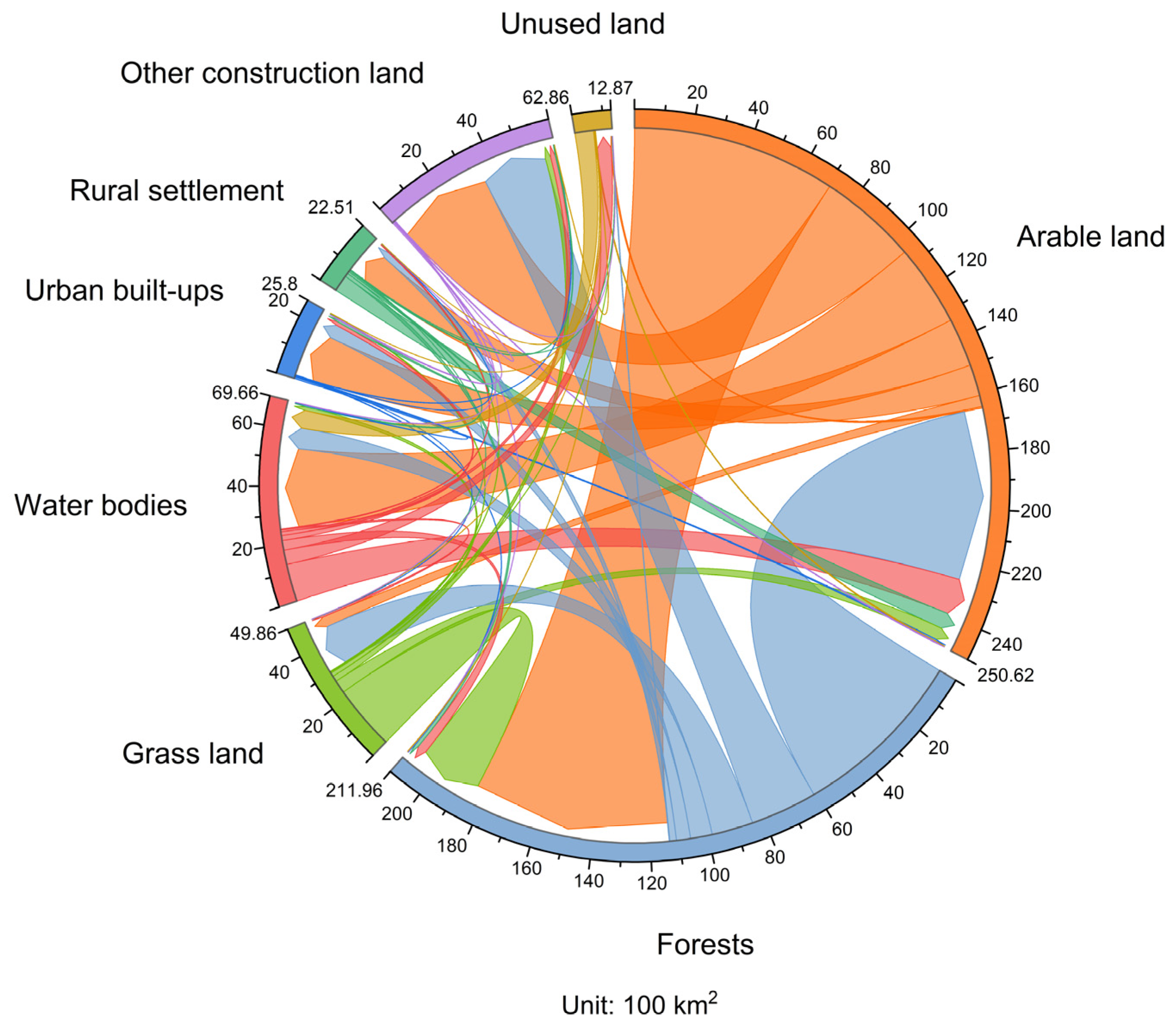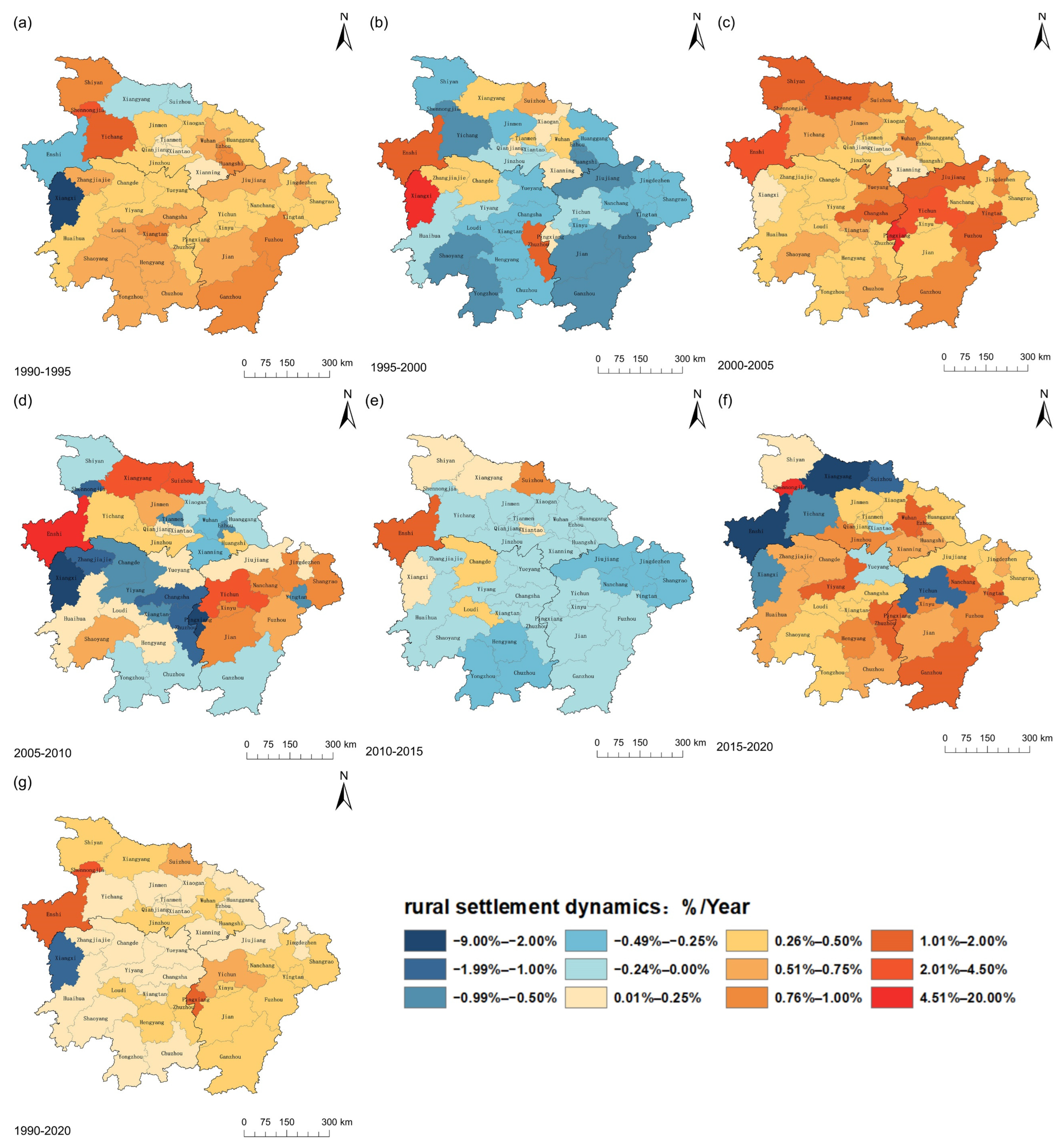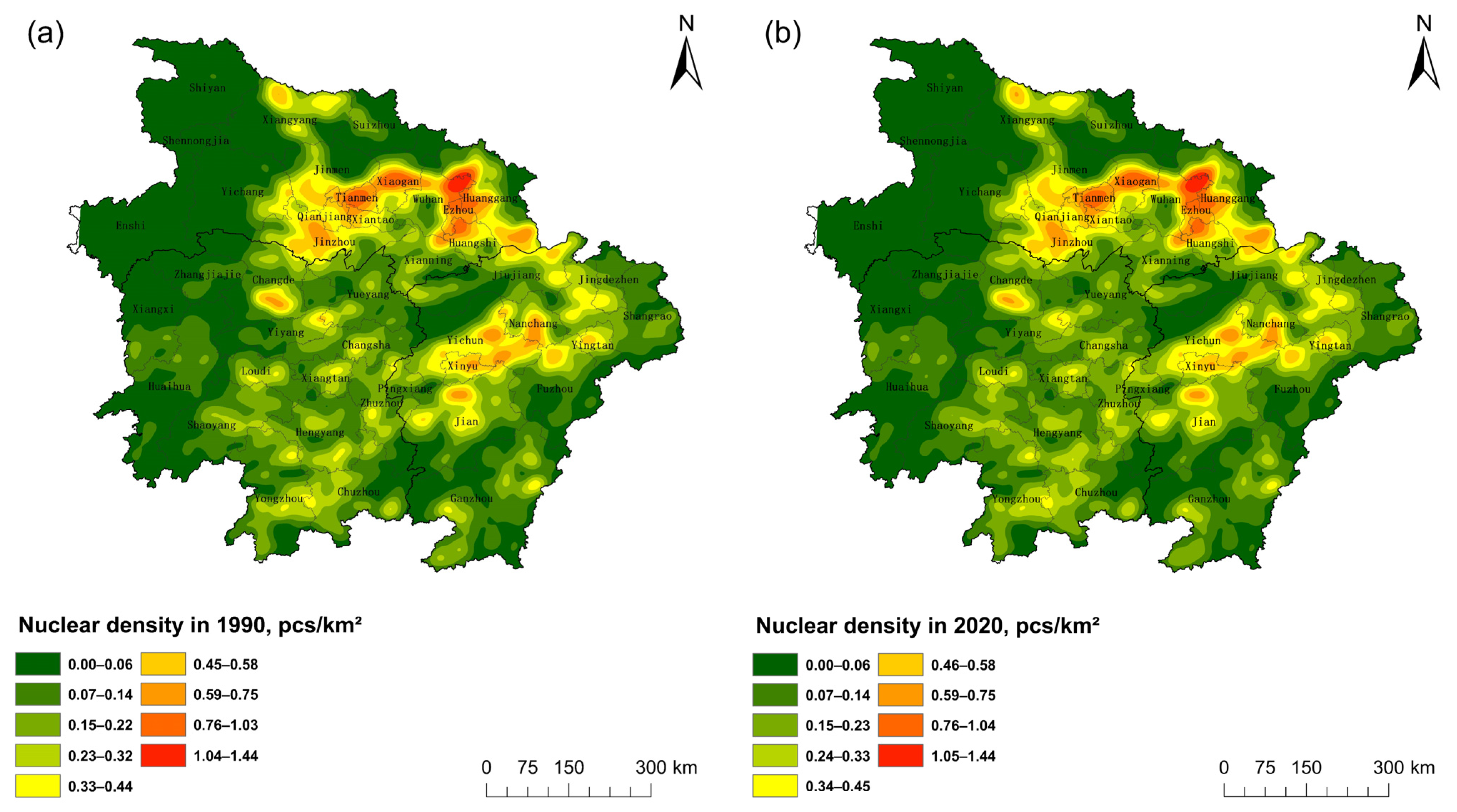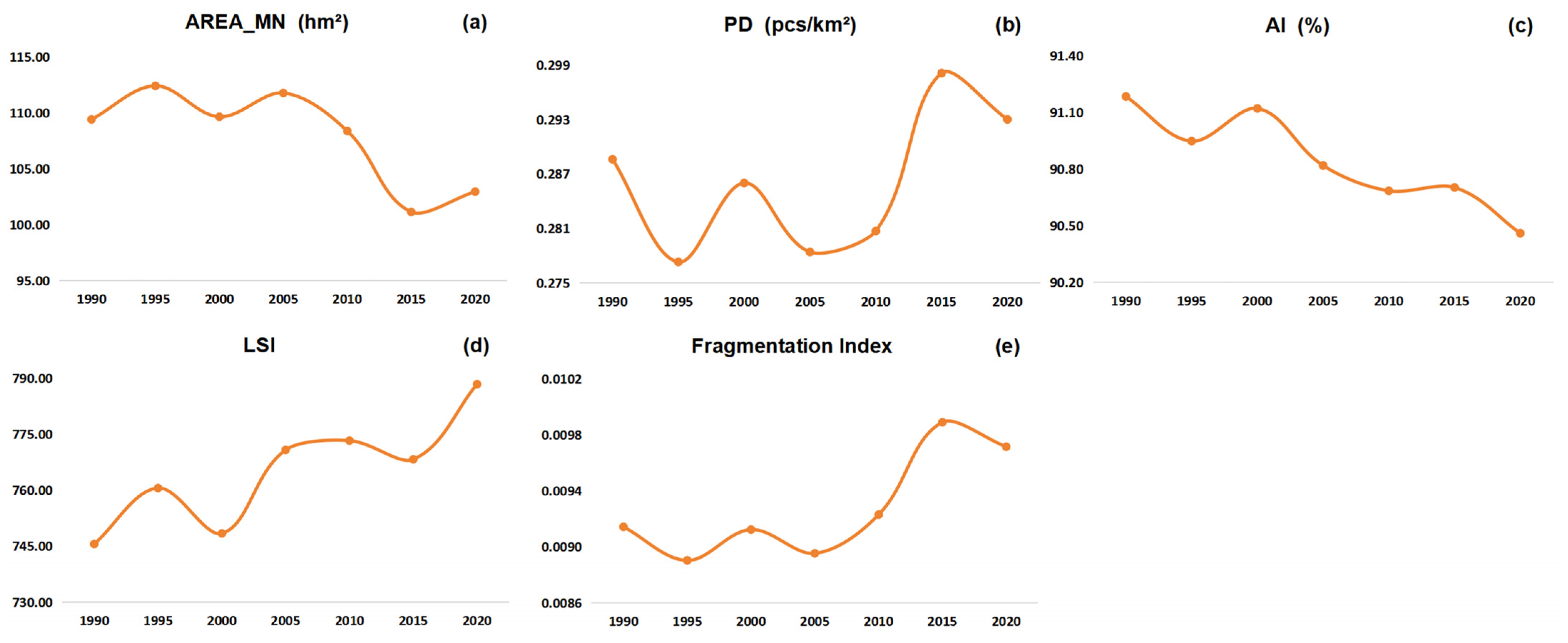Spatiotemporal Changes and Influencing Factors of Rural Settlements in the Middle Reaches of the Yangtze River Region, 1990–2020
Abstract
:1. Introduction
2. Materials and Methods
2.1. Study Area
2.2. Data Sources and Preconditioning
2.3. Methods
2.3.1. Changes in Rural Settlements
2.3.2. Kernel Density Analysis
2.3.3. Morphology Characteristics Based on Landscape Pattern Index
2.3.4. Geographic Detector
3. Results
3.1. Changes in the Amount of Rural Settlements
3.1.1. Changes at the Provincial Level
3.1.2. Changes at the Municipal Level
3.2. Density Analysis of Rural Settlements
3.3. Analysis of Landscape Patterns in Rural Settlements
3.4. Analysis of Driving Factors of Rural Settlements
3.4.1. Selection of Factors
3.4.2. Analysis of Factor Detector Results
3.4.3. Analysis of Interaction Detector Results
4. Discussion
4.1. The Complexity of Rural Settlements’ Changes in the MRYRR
4.2. The Potential Impact of Expansion of Rural Settlements on Arable Land Spatial Distribution
4.3. The Driving Factors behind Changes in Rural Settlements in the MRYRR
4.4. Limitations and Future Prospects
5. Conclusions
Author Contributions
Funding
Data Availability Statement
Conflicts of Interest
References
- Zhou, G.; He, Y.; Tang, C.; Yu, T.; Xiao, G.; Zhong, T. Dynamic mechanism and present situation of rural settlement evolution in China. J. Geogr. Sci. 2013, 23, 513–524. [Google Scholar] [CrossRef]
- Lu, M.; Wei, L.; Ge, D.; Sun, D.; Zhang, Z.; Lu, Y. Spatial optimization of rural settlements based on the perspective of appropriateness-domination: A case of Xinyi City. Habitat Int. 2020, 98, 102148. [Google Scholar] [CrossRef]
- Bittner, C.; Sofer, M. Land use changes in the rural—Urban fringe: An Israeli case study. Land Use Policy 2013, 33, 11–19. [Google Scholar] [CrossRef]
- Hosseini, S.B.; Faizi, M.; Norouzian-Maleki, S.; Azari, A.R.K. Impact evaluation of rural development plans for renovating and retrofitting of rural settlements Case Study: Rural Districts of Tafresh in Iran. Environ. Earth Sci. 2015, 73, 3033–3042. [Google Scholar] [CrossRef]
- Lang, W.; Long, Y.; Chen, T. Rediscovering Chinese cities through the lens of land-use patterns. Land Use Policy 2018, 79, 362–374. [Google Scholar] [CrossRef]
- Cao, W.; Zhou, S.; Zhou, M. Operational Pattern of Urban-Rural Integration Regulated by Land Use in Metropolitan Fringe of China. Land 2021, 10, 515. [Google Scholar] [CrossRef]
- Song, W.; Chen, B.M.; Zhang, Y. Land-use change and socio-economic driving forces of rural settlement in China from 1996 to 2005. Chin. Geogr. Sci. 2014, 24, 511–524. [Google Scholar] [CrossRef]
- Li, Y.; Jia, L.; Wu, W.; Yan, J.; Liu, Y. Urbanization for rural sustainability—Rethinking China’s urbanization strategy. J. Clean. Prod. 2018, 178, 580–586. [Google Scholar] [CrossRef]
- Liu, Y.; Liu, Y.; Chen, Y.; Long, H. The process and driving forces of rural hollowing in China under rapid urbanization. J. Geogr. Sci. 2010, 20, 876–888. [Google Scholar] [CrossRef]
- Long, H.; Qu, Y. Land use transitions and land management: A mutual feedback perspective. Land Use Policy 2018, 74, 111–120. [Google Scholar] [CrossRef]
- Winkler, K.; Fuchs, R.; Rounsevell, M.; Herold, M. Global land use changes are four times greater than previously estimated. Nat. Commun. 2021, 12, 2501. [Google Scholar] [CrossRef] [PubMed]
- van Vliet, J.; de Groot, H.L.F.; Rietveld, P.; Verburg, P.H. Manifestations and underlying drivers of agricultural land use change in Europe. Landsc. Urban. Plan. 2015, 133, 24–36. [Google Scholar] [CrossRef]
- Hashem, D.; Parviz, A.; Mahdis, M. Land use change, urbanization, and change in landscape pattern in a metropolitan area. Sci. Total Environ. 2019, 655, 707–719. [Google Scholar] [CrossRef]
- Wang, J.; Zhang, Y. Analysis on the Evolution of Rural Settlement Pattern and Its Influencing Factors in China from 1995t o 2015. Land 2021, 10, 1137. [Google Scholar] [CrossRef]
- Wang, J.; Wang, X.; Du, G.; Zhang, H. Temporal and Spatial Changes of Rural Settlements and Their Influencing Factors in Northeast China from 2000 to 2020. Land 2022, 11, 1640. [Google Scholar] [CrossRef]
- Li, K.; Geng, H.; Yue, L.; Li, K.; Huang, L. Spatial Differentiation Characteristics and Driving Mechanism of Rural Settlements Transformation in the Metropolis: A Case Study of Pudong District, Shanghai. Front. Env. Sci. 2021, 9, 755207. [Google Scholar] [CrossRef]
- Tan, S.; Zhang, M.; Wang, A.; Ni, Q. Spatio-Temporal Evolution and Driving Factors of Rural Settlementsin Low Hilly Region—A Case Study of 17 Citiesin Hubei Province, China. Int. J. Environ. Res. Public Health 2021, 18, 2387. [Google Scholar] [CrossRef]
- Zhang, R.; Zhang, X. Spatial Pattern Evolution and Driving Mechanism of Rural Settlements in Rapidly Urbanized Areas: A Case Study of Jiangning District in Nanjing City, China. Land 2023, 12, 749. [Google Scholar] [CrossRef]
- Shach-Pinsly, D.; Shadar, H. Towards Rural Regeneration in a Post-Agricultural and Post-Ideological Era. Land 2023, 12, 896. [Google Scholar] [CrossRef]
- Conrad, C.; Rudloff, M.; Abdullaev, I.; Thiel, M.; Loew, F.; Lamers, J.P.A. Measuring rural settlement expansion in Uzbekistan using remote sensing to support spatial planning. Appl. Geogr. 2015, 62, 29–43. [Google Scholar] [CrossRef]
- Dietler, D.; Farnham, A.; de Hoogh, K.; Winkler, M.S. Quantification of Annual Settlement Growth in Rural Mining Areas Using Machine Learning. Remote Sens. 2020, 12, 235. [Google Scholar] [CrossRef]
- Gosch, M.S.; Parente, L.L.; Santos, C.O.D.; Mesquita, V.V.; Ferreira, L.G. Landsat-based assessment of the quantitative and qualitative dynamics of the pasture areas in rural settlements in the Cerrado biome, Brazil. Appl. Geogr. 2021, 136, 102585. [Google Scholar] [CrossRef]
- Li, H.; Yuan, Y.; Zhang, X.; Li, Z.; Wang, Y.; Hu, X. Evolution and transformation mechanism of the spatial structure of rural settlements from the perspective of long-term economic and social change: A case study of the Sunan region, China. J. Rural Stud. 2022, 93, 234–243. [Google Scholar] [CrossRef]
- Liu, Y.; Yang, Y.; Li, Y.; Li, J. Conversion from rural settlements and arable land under rapid urbanization in Beijing during 1985–2010. J. Rural Stud. 2017, 51, 141–150. [Google Scholar] [CrossRef]
- Qu, Y.; Jiang, G.; Tian, Y.; Shang, R.; Wei, S.; Li, Y. Urban—Rural construction land Transition (URCLT) in Shandong Province of China: Features measurement and mechanism exploration. Habitat Int. 2019, 86, 101–115. [Google Scholar] [CrossRef]
- Tan, M.; Li, X. The changing settlements in rural areas under urban pressure in China: Patterns, driving forces and policy implications. Landsc. Urban. Plan. 2013, 120, 170–177. [Google Scholar] [CrossRef]
- Song, W.; Li, H. Spatial pattern evolution of rural settlements from 1961 to 2030 in Tongzhou District, China. Land Use Policy 2020, 99, 105044. [Google Scholar] [CrossRef]
- Yang, R.; Xu, Q.; Long, H. Spatial distribution characteristics and optimized reconstruction analysis of China’s rural settlements during the process of rapid urbanization. J. Rural Stud. 2016, 47, 413–424. [Google Scholar] [CrossRef]
- Zhang, R.; Jiang, G.; Zhang, Q. Does urbanization always lead to rural hollowing? Assessing the spatio-temporal variations in this relationship at the county level in China 2000-2015. J. Clean. Prod. 2019, 220, 9–22. [Google Scholar] [CrossRef]
- Owen, C.; Jacqueline, B. Causes of urbanisation and counter-urbanisation in Zambia: Natural population increase or migration? Urban. Stud. 2019, 56, 2005–2020. [Google Scholar] [CrossRef]
- Tan, X.; Zhou, G.; Zhu, S.; Ou, C. Landscape Pattern Changes and the Characteristic of Spatio-temporal Differentiation of Rural Residential Area in Changsha in Recent 20 Years. Sci. Geogr. Sin. 2015, 35, 204–210, (In Chinese with English Abstract). [Google Scholar]
- Phil, M.; Jim, W.; Neil, A.; Scott, B.; Lisa, B.; John, M.; Bill, P.; Tony, S. Rural Community and Rural Resilience: What is important to farmers in keeping their country towns alive? J. Rural Stud. 2011, 28, 20–29. [Google Scholar] [CrossRef]
- Tian, G.; Qiao, Z.; Gao, X. Rural settlement land dynamic modes and policy implications in Beijing metropolitan region, China. Habitat Int. 2014, 44, 237–246. [Google Scholar] [CrossRef]
- Coluzzi, R.; Bianchini, L.; Egidi, G.; Cudlin, P.; Imbrenda, V.; Salvati, L.; Lanfredi, M. Density matters? Settlement expansion and land degradation in Peri-urban and rural districts of Italy. Environ. Impact Asses 2022, 92, 106703. [Google Scholar] [CrossRef]
- McLeman, R.A. Settlement abandonment in the context of global environmental change. Glob. Environ. Chang. 2011, 21, S108–S120. [Google Scholar] [CrossRef]
- Fayet, C.M.J.; Reilly, K.H.; Van Ham, C.; Verburg, P.H. What is the future of abandoned agricultural lands? A systematicre view of alternative trajectories in Europe. Land Use Policy 2022, 112, 105833. [Google Scholar] [CrossRef]
- Yin, X.; Chen, J.; Li, J. Rural innovation system: Revitalize the countryside for a sustainable development. J. Rural Stud. 2019, 93, 471–478. [Google Scholar] [CrossRef]
- Liu, Y.; Zang, Y.; Yang, Y. China’s rural revitalization and development: Theory, technology and management. J. Geogr. Sci. 2020, 30, 1923–1942. [Google Scholar] [CrossRef]
- Zhang, R.; Zhang, X. Distribution Characteristics and Influencing Factors of Rural Settlements in Metropolitan Fringe Area: A Case Study of Nanjing, China. Land 2022, 11, 1989. [Google Scholar] [CrossRef]
- Wu, K.; Zhang, H. Land use dynamics, built-up land expansion patterns, and driving forces analysis of the fast-growing Hangzhou metropolitan area, eastern China (1978–2008). Appl. Geogr. 2012, 34, 137–145. [Google Scholar] [CrossRef]
- Long, H.; Zhang, Y.; Tu, S. Rural vitalization in China: A perspective of land consolidation. J. Geogr. Sci. 2019, 29, 517–530. [Google Scholar] [CrossRef]
- Zhang, X.; He, J.; Deng, Z.; Ma, J.; Chen, G.; Zhang, M.; Li, D. Comparative Changes of Influence Factors of Rural Residential Area Based on Spatial Econometric Regression Model: A Case Study of Lishan Township, Hubei Province, China. Sustainability 2018, 10, 3403. [Google Scholar] [CrossRef]
- Rosner, A.; Wesolowska, M. Deagrarianisation of the Economic Structure and the Evolution of Rural Settlement Patterns in Poland. Land 2020, 9, 523. [Google Scholar] [CrossRef]
- You, T.; Yan, S. Spatial Differentiation and Driving Force Detection of Rural Settlements in the Yangtze River Delta Region. Sustainability 2023, 15, 8774. [Google Scholar] [CrossRef]
- Gong, J.; Jian, Y.; Chen, W.; Liu, Y.; Hu, Y. Transitions in rural settlements and implications for rural revitalization in Guangdong Province. J. Rural Stud. 2019, 93, 359–366. [Google Scholar] [CrossRef]
- Li, Y.; Liu, Y.; Long, H.; Cui, W. Community-based rural residential land consolidation and allocation can help to revitalize hollowed villages in traditional agricultural areas of China: Evidence from Dancheng County, Henan Province. Land Use Policy 2014, 39, 188–198. [Google Scholar] [CrossRef]
- Wen, Y.; Zhang, Z.; Liang, D.; Xu, Z. Rural Residential Land Transition in the Beijing-Tianjin-Hebei Region: Spatial-Temporal Patterns and Policy Implications. Land Use Policy 2020, 96, 104700. [Google Scholar] [CrossRef]
- Niu, X.; Liao, F.; Liu, Z.; Wu, G. Spatial-Temporal Characteristics and Driving Mechanisms of Land-Use Transition from the Perspective of Urban-Rural Transformation Development: A Case Study of the Yangtze River Delta. Land 2022, 11, 631. [Google Scholar] [CrossRef]
- Liu, Y.; Long, H. Land use transitions and their dynamic mechanism: The case of the Huang-Huai-Hai Plain. J. Geogr. Sci. 2016, 26, 515–530. [Google Scholar] [CrossRef]
- Xiao, X.; Huang, X.; Jiang, L.; Jin, C. Empirical study on comparative analysis of dynamic degree differences of land use based on the optimization model. Geocarto Int. 2022, 37, 9847–9864. [Google Scholar] [CrossRef]
- Wang, J.; Xu, C. Geodetector: Principle and prospective. Acta Geogr. Sin. 2017, 72, 116–134, (In Chinese with English Abstract). [Google Scholar]
- Fu, F.; Liu, W.; Wu, D.; Deng, S.; Bai, Z. Research on the Spatiotemporal Evolution of Land Use Landscape Pattern in a County Area Based on CA-Markov Model. Sustain. Cities Soc. 2022, 80, 103760. [Google Scholar] [CrossRef]
- Chen, Z.; Liu, Y.; Feng, W.; Li, Y.; Li, L. Study on spatial tropism distribution of rural settlements in the Loess Hilly and Gully Region based on natural factors and traffic accessibility. J. Rural Stud. 2019, 93, 441–448. [Google Scholar] [CrossRef]
- Liu, Y.; Yang, R.; Long, H.; Gao, J.; Wang, J. Implications of land-use change in rural China: A case study of Yucheng, Shandong province. Land Use Policy 2014, 40, 111–118. [Google Scholar] [CrossRef]
- Luan, W.; Zhang, S.; Li, Y.; Zheng, X. Spatiotemporal Differentiation and Influencing Factors of Chinese’s Tourism Demand to Thailand. Tour. Trib. 2019, 34, 76–89, (In Chinese with English Abstract). [Google Scholar]
- Wang, D.; Zhu, Y.; Zhao, M.; Lv, Q. Multi-dimensional hollowing characteristics of traditional villages and its influence mechanism based on the micro-scale: A case study of Dongcun Village in Suzhou, China. Land Use Policy 2020, 101, 105146. [Google Scholar] [CrossRef]
- Wang, J.; Lin, Y.; Glendinning, A.; Xu, Y. Land-use changes and land policies evolution in China’s urbanization processes. Land Use Policy 2018, 75, 375–387. [Google Scholar] [CrossRef]
- Wang, Z.; Fang, C.; Wang, J. Observation and Reflection on Land Policy of Linking the Increase in Land Used for Urban Construction with the Decrease in Land Used for Rural Construction. China Popul. Resour. Environ. 2012, 22, 96–102, (In Chinese with English Abstract). [Google Scholar]
- Li, H.; Song, W. Expansion of Rural Settlements on High-Quality Arable Land in Tongzhou District in Beijing, China. Sustainability 2019, 11, 5153. [Google Scholar] [CrossRef]
- Liu, S.; Xiao, W.; Ye, Y.; He, T.; Luo, H. Rural residential land expansion and its impacts on cultivated land in China between 1990 and 2020. Land Use Policy 2023, 132, 106816. [Google Scholar] [CrossRef]
- Pang, R.; Xu, H.; Zhang, M.; Qian, F. Spatial correlation and impact mechanism analysis of cultivated land fragmentation and quality in the Central Plain of Liaoning Province, Northeast China. Land. Degrad. Dev. 2023; early view. [Google Scholar] [CrossRef]
- Tolessa, T.; Senbeta, F.; Kidane, M. Landscape composition and configuration in the central highlands of Ethiopia. Ecol. Evol. 2016, 6, 7409–7421. [Google Scholar] [CrossRef]
- Liu, J.; Jin, X.; Xu, W.; Zhou, Y. Evolution of cultivated land fragmentation and its driving mechanism in rural development: A case study of Jiangsu Province. J. Rural Stud. 2022, 91, 58–72. [Google Scholar] [CrossRef]
- Uisso, A.M.; Tanrivermis, H. Driving factors and assessment of changes in the use of arable land in Tanzania. Land Use Policy 2021, 104, 105359. [Google Scholar] [CrossRef]
- Wu, Y.; Shan, L.; Guo, Z.; Peng, Y. Cultivated land protection policies in China facing 2030: Dynamic balance system versus basic farmland zoning. Habitat Int. 2017, 69, 126–138. [Google Scholar] [CrossRef]
- Long, H.; Gerhard, K.H.; Li, X.; Zhang, M. Socio-economic development and land-use change: Analysis of rural housing land transition in the Transect of the Yangtse River, China. Land Use Policy 2005, 24, 141–153. [Google Scholar] [CrossRef]
- Wei, S.; Bryan, C.P. The effects of China’s cultivated land balance program on potential land productivity at a national scale. Appl. Geogr. 2014, 46, 158–170. [Google Scholar]
- Huang, Q.; Song, W.; Song, C. Consolidating the layout of rural settlements using system dynamics and the multi-agent system. J. Clean. Prod. 2020, 274, 123150. [Google Scholar] [CrossRef]
- CAO, Y.; Li, G.; Cao, Y.; Wang, J.; Fang, X.; Zhou, L.; Liu, Y. Distinct types of restructuring scenarios for rural settlements in a heterogeneous rural landscape: Application of a clustering approach and ecological niche modeling. Habitat Int. 2020, 104, 102248. [Google Scholar] [CrossRef]










| Index Names | Abbreviations | Significance |
|---|---|---|
| Class area | CA | Overall area of a particular patch type. |
| Average patch area | AREA_MN | Mean of the patch area. |
| Number of patches | NP | Total number of patches of a specific landscape type. |
| Perimeter area fractional dimension | PAFRAC | This index is employed to assess the level of human-induced disruption to the landscape pattern. A value nearing 1 indicates a landscape characterized by simple patch shapes and minimal human disturbance. Conversely, a value approaching 2 suggests a landscape with more intricate patch shapes and greater human disturbance. |
| Patch density | PD | The density of a specific patch type within a landscape provides insights into the overall heterogeneity and fragmentation of the landscape, as well as the degree of fragmentation associated with that specific patch type, reflecting the heterogeneity of the landscape per unit area. |
| Aggregation index | AI | The aggregation index examines the connectivity between patches of each landscape type. The smaller the value, the more discrete the landscape. |
| Landscape shape index | LSI | Used to describe the minimum possible value of the total edge length divided by the total edge length of the relevant patch type; reflects the degree of irregularity in the shape of the landscape patches and characterizes the complexity of the landscape shape. |
| 1990 | 1995 | 2000 | 2005 | 2010 | 2015 | 2020 | |
|---|---|---|---|---|---|---|---|
| Area of rural settlements (km2) | 7275.70 | 7394.94 | 7366.45 | 7646.63 | 7722.96 | 7681.02 | 7780.40 |
| Land Use Types | Area (km2) | Percentage (%) | Land Use Types | Area (km2) | Percentage (%) | ||
|---|---|---|---|---|---|---|---|
| Area of other land use types transfer to rural settlement | Arable land | 1086.07 | 78.55 | Area of rural settlement transfer to other land use types | Arable land | 574.70 | 66.27 |
| Forests | 229.75 | 16.62 | Forests | 126.76 | 14.62 | ||
| Grassland | 19.20 | 1.39 | Grassland | 6.43 | 0.74 | ||
| Water bodies | 32.63 | 2.36 | Water bodies | 45.52 | 5.25 | ||
| Urban built-ups | 10.39 | 0.75 | Urban built-ups | 73.55 | 8.48 | ||
| Unused land | 1.22 | 0.09 | Unused land | 2.31 | 0.27 | ||
| Other construction land | 3.31 | 0.24 | Other construction land | 37.97 | 4.38 | ||
| Total | 1382.57 | 100 | Total | 867.24 | 100 |
| Study Periods | Changes in Area (km2) | Rural Settlement Dynamics (%) |
|---|---|---|
| 1990–1995 | 119.24 | 0.328 |
| 1995–2000 | −28.50 | −0.077 |
| 2000–2005 | 280.18 | 0.761 |
| 2005–2010 | 76.33 | 0.200 |
| 2010–2015 | −41.94 | −0.109 |
| 2015–2020 | 99.39 | 0.259 |
| 1990–2020 | 504.70 | 0.231 |
| Study Periods | Hubei Province | Hunan Province | Jiangxi Province |
|---|---|---|---|
| 1990–1995 | 0.38% | −0.07% | 0.55% |
| 1995–2000 | −0.11% | 0.47% | −0.44% |
| 2000–2005 | 0.48% | 0.52% | 1.44% |
| 2005–2010 | 0.46% | −0.84% | 0.57% |
| 2010–2015 | −0.05% | −0.08% | −0.23% |
| 2015–2020 | 0.24% | −0.01% | 0.38% |
| 1990–2020 | 0.20% | 0.09% | 0.40% |
| Factors | Factor Descriptions |
|---|---|
| Total rural population (X1) | Total rural population by municipality at the end of the year. |
| Agricultural workers (X2) | Persons who are directly engaged in agricultural production and whose main source of income is from agriculture. |
| Effective irrigated area (X3) | The area of farmland that is relatively flat, has some water bodies supply and irrigation facilities, and can be irrigated normally in the current year under normal conditions. |
| Net income per rural resident (X4) | The part of the total annual income of a rural household that can be used directly for productive and non-productive construction investments, living consumption, and savings, after deducting production and non-productive business expenses, paying taxes, and handing over the amount of contracted collective tasks. |
| Rural electricity consumption (X5) | Total annual electricity consumption for rural production and domestic use in the corresponding year after deducting the electricity consumption of rural state-owned economic units. |
| Arable land area (X6) | Total area of fields that can be cultivated. |
| Output value of primary industry (X7) | Total value of production of various types of professional farmers and various types of raw agricultural products such as aquatic and indigenous. |
| Proportion of output value of primary industry (X8) | The ratio of primary sector output to GDP. |
| Total grain production (X9) | Total yield of grains produced by agricultural producers and operators. |
| Urbanization rate (X10) | The urbanization rate represents the ratio of the urban population to the total population of a specific region or country. It serves as a fundamental indicator for quantifying the extent of urbanization within that area. |
| Distance from road networks (X11) | Euclidean distance of rural settlements from main roads. |
| Elevation (X12) | The altitude at which the rural settlement is located. |
| Slope (X13) | Degree of terrain at which the rural settlement is located. |
Disclaimer/Publisher’s Note: The statements, opinions and data contained in all publications are solely those of the individual author(s) and contributor(s) and not of MDPI and/or the editor(s). MDPI and/or the editor(s) disclaim responsibility for any injury to people or property resulting from any ideas, methods, instructions or products referred to in the content. |
© 2023 by the authors. Licensee MDPI, Basel, Switzerland. This article is an open access article distributed under the terms and conditions of the Creative Commons Attribution (CC BY) license (https://creativecommons.org/licenses/by/4.0/).
Share and Cite
Yao, X.; Wu, D. Spatiotemporal Changes and Influencing Factors of Rural Settlements in the Middle Reaches of the Yangtze River Region, 1990–2020. Land 2023, 12, 1741. https://doi.org/10.3390/land12091741
Yao X, Wu D. Spatiotemporal Changes and Influencing Factors of Rural Settlements in the Middle Reaches of the Yangtze River Region, 1990–2020. Land. 2023; 12(9):1741. https://doi.org/10.3390/land12091741
Chicago/Turabian StyleYao, Xiaowei, and Di Wu. 2023. "Spatiotemporal Changes and Influencing Factors of Rural Settlements in the Middle Reaches of the Yangtze River Region, 1990–2020" Land 12, no. 9: 1741. https://doi.org/10.3390/land12091741
APA StyleYao, X., & Wu, D. (2023). Spatiotemporal Changes and Influencing Factors of Rural Settlements in the Middle Reaches of the Yangtze River Region, 1990–2020. Land, 12(9), 1741. https://doi.org/10.3390/land12091741





